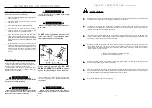
5
16
S A F E T Y I N S T R U C T I O N S
(continued)
Safety is a primary concern in the design and manufacture of our products. Unfortunately, our efforts to provide
safe equipment can be wiped out by a single careless act of an operator.
Know your controls and how to stop tractor, engine, and loader quickly in an emergency. Read this manual
and the one provided with your tractor or skid steer.
In addition to the design and configuration of equipment, hazard control and accident prevention are
dependent upon the awareness, concern, prudence and proper training of personnel involved in the operation,
transport, maintenance and storage of equipment.
It has been said, “The best safety device is an informed, careful operator.” We ask you to be that kind of an
operator. It is the operator’s responsibility to read and understand ALL Safety and Operating instructions in the
manual and to follow these. Accidents can be avoided.
Train all new personnel and review instructions frequently with existing workers. A person who has not read
and understood all operating and safety instructions is not qualified to operate the machine. An untrained oper-
ator exposes himself and bystanders to possible serious injury or death.
Working with unfamiliar equipment can lead to careless injuries. Read this manual, and the manual for your
tractor, before assembly or operating, to acquaint yourself with the machines. It is the equipment owner’s
responsibility, if this machine is used by any person other than yourself, is loaned or rented, to make certain
that the operator, prior to operating:
1. Reads and understands the operator’s manuals.
2. Is instructed in safe and proper use.
SAFETY TRAINING
Do not allow children to operate this machine.
O P E R AT I O N
Be sure tractor or skid steer is properly counterbal-
anced with weights before attempting to lift any load.
Using the bucket tilt cylinders, adjust the angle of the
fork tines so they are parallel with the ground.
Adjust height of fork tines to enter the pallet to be
handled. Always keep the load or pallet as close to the
forklift main frame as possible.
Never exceed the lift capacity of the tractor/loader
or skid steer used with the forklift.
C A U T I O N !
The ULF-346, VLF-7646 and SSPF-40 Front Loader
Forks are NOT to be used for large round bales, as
this would create a hazardous condition.
C A U T I O N !
Avoid carrying loose or shiftable loads. Falling
items could cause injury.
C A U T I O N !
O P E R AT I N G I N S T R U C T I O N S
P R E - O P E R AT I O N C H E C K L I S T
(OWNER/OPERATOR RESPONSIBILITY)
____ Review and follow safety rules and safety signs on
pages 3 through 13.
____ Check that Loader Fork is properly and securely
attached to loader.
____ Check that all hardware is properly installed.
____ Check that no one enters the area of machine
operation. Always work at a safe distance from
roads, built-up areas, or populated places.
____ Know your controls and how to stop skid steer,
tractor, engine and PTO quickly in an emergency.
READ THIS MANUAL AND THE ONE PROVIDED
WITH YOUR TRACTOR AND LOADER OR SKID
STEER.
____ To avoid accident or injury, do not allow anyone to
operate this equipment without proper instructions.
Any person who operates this equipment must be
instructed in and be capable of the safe operation
of the tractor, skid steer, implement and all
controls.
When working on side hills, DO NOT
RAISE LOADER TOO HIGH. Keep an
eye on terrain changes. Keep load low.
C A U T I O N !
Beware of lift clearance when raising loader to max-
imum height.
When stacking hay bales or loading vehicles, make
sure you are operating in an area AWAY FROM OVER-
HEAD WIRES.
D A N G E R !
Beware of low electrical wires when loader is
raised. Serious injury or death can result if contact is
made.
Do NOT carry round bales with short 46”
forks. Use only 55” long forks and stabi-
lizer spike to handle round bales.
























